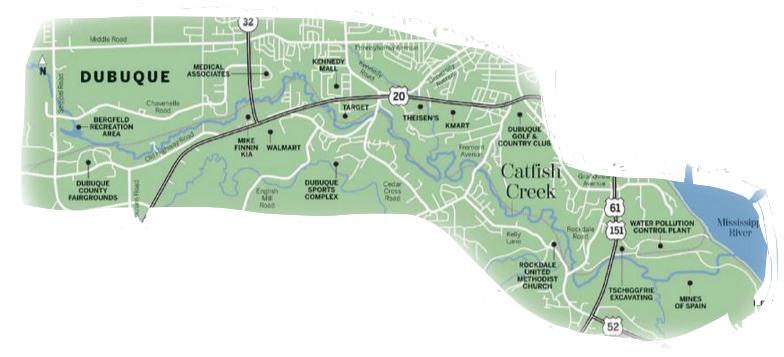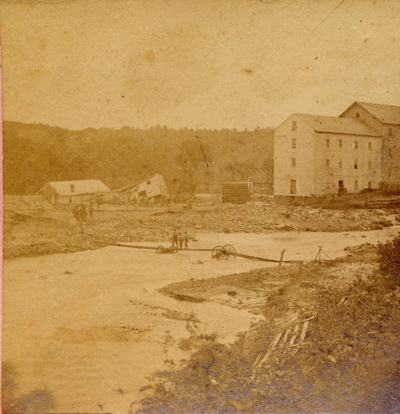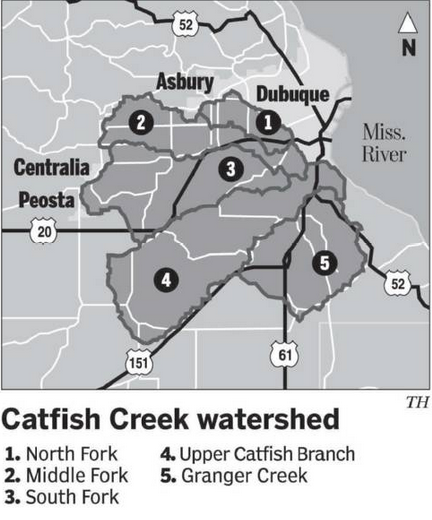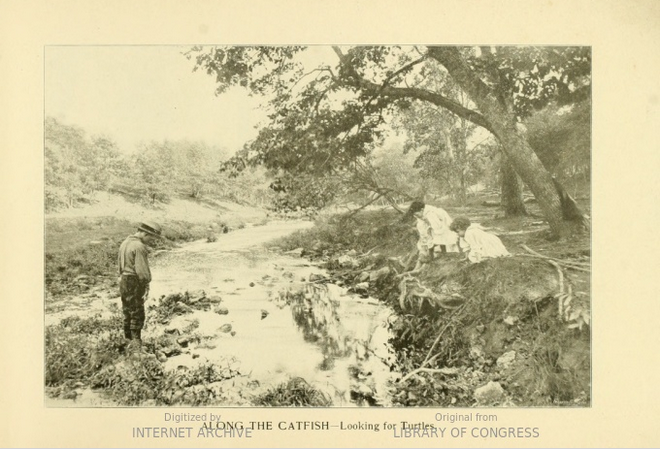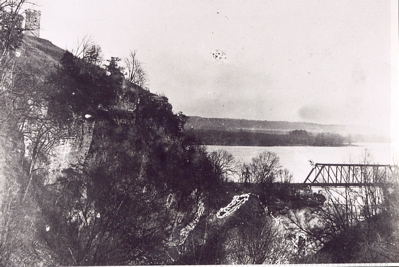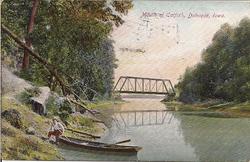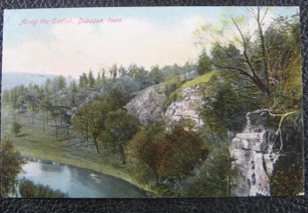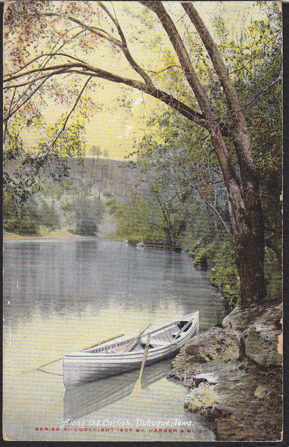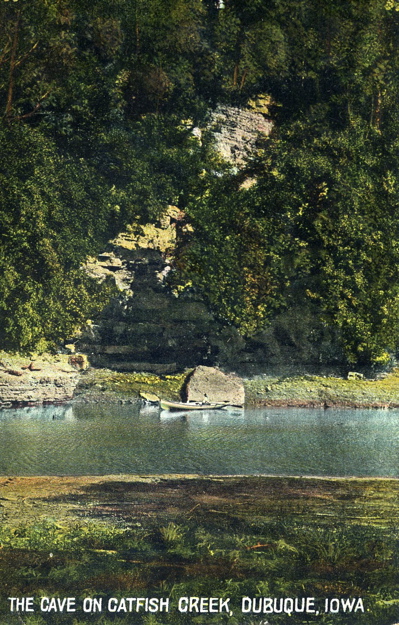Encyclopedia Dubuque
"Encyclopedia Dubuque is the online authority for all things Dubuque, written by the people who know the city best.”
Marshall Cohen—researcher and producer, CNN
Affiliated with the Local History Network of the State Historical Society of Iowa, and the Iowa Museum Association.
CATFISH CREEK: Difference between revisions
No edit summary |
No edit summary |
||
| (40 intermediate revisions by the same user not shown) | |||
| Line 1: | Line 1: | ||
[[Image:CATFISH CREEK.png|left|thumb|450px|Winding through the City of Dubuque, Catfish Creek has an enormous watershed.Photo courtesy: Telegraph Herald]] CATFISH CREEK. A minor tributary of the [[MISSISSIPPI RIVER]], Catfish Creek rises west and southwest of Dubuque, Iowa. The Middle Fork flows under and then parallel to U.S. Highway 20. The remaining forks of the creek are all south of Highway 52. Swiss Valley Park, maintained by Dubuque County, is on the main fork. The section of the creek in Swiss Valley is a designated trout stream. (1) The portion running through the Mines of Spain State Recreation Area has increased in popularity for “quiet water activities” such as canoeing, kayaking, water-based eco-tours and wildlife watching. | |||
In the late 1700s, the [[ | In the late 1700s, the [[MESKWAKIES]] located a village near the mouth of Catfish Creek and mined [[LEAD]] in the area. In 1788 they allowed [[DUBUQUE, Julien|Julien DUBUQUE]] to live along the stream and operate the mines. Near the mouth of the stream, his settlement included a smelter and blacksmith shop. | ||
[[Image:imp912.jpg| | [[Image:imp912.jpg|right|thumb|250px|Rockdale disaster.]] | ||
On the evening of June 4, 1876, a downpour of rain caused Catfish Creek to surge out of its banks to a depth of perhaps twenty-feet and a width of hundreds of feet. The village of [[ROCKDALE]] suffered the loss of two stores, several houses, a hotel, saloon, post office, and blacksmith shop. Reports stated that forty-two people died with survivors found in tree tops. | |||
[[Image:watershed1.png|left|thumb|250px|Photo courtesy: Telegraph Herald]]The Catfish Creek Watershed is a 46,300 acre area consisting of the City of Dubuque, City of Asbury, and the City of Peosta. There are five sub-watersheds within the Catfish Creek Watershed. These include: the North Fork, Middle Fork, South Fork, Granger Creek, and the main stem of Catfish Creek. (2) The Iowa Department of Natural Resources (IDNR) has labeled Upper Catfish Creek a cold-water Class "B"(CW) stream from the Swiss Valley Park Campgrounds and south approximately 3 miles. This stream has brown trout naturally reproducing within it--one of only thirty such streams in Iowa. Along with the urban area the stream impacts, the creek meanders through the three important natural resources within the watershed: Swiss Valley Park, the Swiss Valley Nature Preserve, and the Mines of Spain State Park. These areas managed by both the Dubuque County Conservation Board and the Iowa Department of Natural Resources attract over 380,000 visitors annually. (3) | |||
Granger Creek, whose source lies east of the [[DUBUQUE REGIONAL AIRPORT]], flows near the [[DUBUQUE TECHNOLOGY PARK]] before entering the Mines of Spain State Recreational Area where it empties into Catfish Creek. The Middle Fork of Catfish Creek with its source west of Seippel Road and south of the Meadows Golf Course, flows through Bergfeld Pond and runs parallel to the railroad tracks until it flows in to the North Fork, the smallest of the five basins. The North flows under the [[NORTHWEST ARTERIAL]], Kennedy Road and Dodge Street and then joins the Middle Fork south of Brunskill Road. In 2010, 60% of the North Fork was realigned and sanitary sewer lines were resized and rebuilt. This eliminated overflow discharges that had become normal during heavy rainfall. The South Fork, rising near Cox Springs Road east of Peosta, flows under Highway 20 and merges with Catfish Creek west of the Rockdale Road Bridge. (4) | |||
In 1974 a 10-20 acre man-made lake was considered west of the Dubuque city limits. By damming the North Fork of the creek at the junction of the Joseph Siegert farm and the city limits just north of Pennsylvania Avenue, a trail/park could be created. The plan would also serve to solve drainage and flooding problems. (4) The dam was planned in conjunction with what was later called the [[NORTHWEST ARTERIAL]]. | |||
In 1997 Catfish Creek was the focus of an environmental checkup by the Iowa Department of Natural Resources. Draining about seventy miles of eastern Dubuque County known as Swiss Valley, Catfish Creek has three major tributaries--South, Middle and North forks of Catfish Creek as well as Granger Creek to the south. Sections of the creek flow through pipes under Kennedy Road and Pennsylvania Avenue. The survey gave biologists a look at the fish distribution--an indicator of water quality. Species found included carp, sunfish, catfish, sauger and bass. Tom Boland, a DNR biologist, was then in the process of raising the visibility of the creek and its watershed by proposing the creation of a Catfish Creek Coalition. (5) Local educators were to be asked for copies of studies they had conducted on water quality, flow, and invertebrates. (6) Officials with the Dubuque County Conservation Society stated at the time that it had lobbied for protection of the creek since 1978. (7) | |||
Landowners and residents working with the Upper Catfish Creek Watershed Project began conservation practices and other changes to improve farming operations. In 2007 a $7,500 grant was awarded by the Iowa Department of Natural Resources to help the Dubuque County Conservation Board control storm-water at the Swiss Valley Nature Center. The grant money helped install a pervious parking area and a permeable grass paver walkway to reduce storm water runoff. | |||
In July 2012 applications were accepted for two positions to represent the City of Dubuque on the newly formed Catfish Creek Watershed Management Authority (CCWMA). The CCWMA, formed by an agreement through a grant contract with the Iowa Economic Development Authority, invited the Catfish Creek Watershed political subdivisions of Dubuque County; the cities of Dubuque, Asbury, Peosta, Centralia; and the Dubuque Soil and Water Conservation District to enter into a joint and cooperative agreement for the establishment of a Catfish Creek Watershed Authority to effectively plan, communicate, educate, and provide guidance for the Catfish Creek Watershed. (8) In October the CWMA received a $187,330 grant by the Iowa Economic Development Authority and the Department of Natural Resources. The Dubuque project was one of three awarded funds by the state. The money was to be used to form a comprehensive plant to improve water quality and reduce flood risks in the Catfish Creek basin. The CWMA would match the money and have 24 months to complete a plan to deal with impairments in the waterway. (9) | |||
To educate and engage the public on water quality and the Catfish Creek Watershed, the City of Dubuque, Catfish Creek Watershed Management Authority, Dubuque County Conservation Board, Dubuque Metropolitan Area Solid Waste Agency, Dubuque Soil & Water Conservation District, and the [[NATIONAL MISSISSIPPI RIVER MUSEUM AND AQUARIUM]] sponsored the first annual Catfish Creek Festival on April 26, 2014 at the Swiss Valley Park Walnut Pavilion, 13606 Swiss Valley Rd. Festivities began with an educational exercise on water quality monitoring, followed by a stream clean-up activity and a presentation by the Catfish Creek Watershed Management Authority. (10) | |||
In September 2017 the Catfish Creek Watershed Management Authority and the City of Dubuque began accepting applications for conservation grants. The new cost-share program offered financial incentives to watershed landowners to install conservation practices on their land. The Authority had an estimated $100,000 to invest within the 46,000-acre watershed. (11) In 2018 Green Dubuque, an environmental organization, worked with the CCWMA to implement conservation practices on local farms. Paul Schultz, president of the organization, however stated his belief that some sort of regulation would be needed if significant progress in reducing nitrogen pollution was to be realized. (12) | |||
Dubuque County supervisors in February 2019 approved expanding testing of local water sources. Voting unanimously, the supervisors approved spending $21,850 on quarterly testing of watershed samples from thirty different locations in the county. Testing conducted by the [[UNIVERSITY OF DUBUQUE]] would focus on nitrates, phosphate, chloride and ammonium commonly introduced by water runoff. Five surface water sources would be tested throughout the year--Catfish Creek, Whitewater Ceek, Little Maquoketa Creek, Bloody Run Creek and Bankston Creek. The University of Dubuque had been testing water samples from Catfish and Whitewater creeks. In 2017 Catfish had shown above-average amounts of phosphate and nitrate. (13) | |||
Funding conservation efforts remained a problem. According to [[ISENHART, Charles|Charles ISENHART]], one of the reasons was that groups were relying on federal disaster relief monies with which a lot of regulation was associated. (14) Dubuque County had been able to develop local partnerships, he added, in which private landowners had established a sense of land stewardship. In November, 2010, Iowa voters approved the Land and Water Legacy Amendment. This created a constitutionally protected trust fund to improve water quality, reduce soil erosion, protect wildlife habitat and fund parks and trails. If there were any future sales tax increases, three-eights of 1% would automatically be added to the fund. (15) | |||
In a previous partnership the city and the Catfish Creek Watershed Management Authority had used $1.4 million in Clean Water State Revolving Fund money to award farmers and other landowners for projects like planting cover crops and using no-till farming to reduce nutrients getting into the water. In 2020 the City of Dubuque and the Iowa Department of Natural Resources signed a memorandum of understand that allowed the city to use upstream conservation projects to help meet state-mandated nutrient reduction goals. This was the first agreement of its kind in the State of Iowa and increased the scope of upstream projects beyond Catfish Creek. The memorandum allowed the city to start building a registry of no-till, cover crops, and sediment basins along the Apple-Plum, Grant-Little Maquoketa and Maquoketa River watersheds that run through Dubuque County. The idea was to use the more efficient ways to reducing surface water nutrient runoff into rivers than spending millions of dollars at the Water & Resource Recovery Center to do the way thing. The Recovery Center was completed in 2012 just before the State of Iowa in 2013 required cities to reduce their nutrient runoff into the Gulf of Mexico. Updating the facility in 2020 was expected to cost $11 million. A feasibility study turned into the state in 2022 would indicate which methods worked best and were cost-efficient. (16) | |||
The biannual report of the Iowa Department of Natural Resources removed over 30 segments of surface water from a list of those impaired. Little changed, however, in eastern Iowa. Surface water considered impaired failed to meet a variety of standards with such indicators as bacteria such as e. Coli. The impaired waters of 2018 and 2020 were nearly identical and both included Catfish Creek. The local waterway was classified as Category 5 meaning a maximum daily load plan needed to be devised and implemented. The newest report also indicated a fish kill in 2014 from yet an unidentified cause. A Category 5 classification did not necessarily mean the water was unsafe for recreation. (17) | |||
[[Image:HB6.png|left|thumb|250px|Looking for turtles. Photo courtesy: '''Dubuque and Its Neighborhoods''', Harber and Blish, 1897]] | |||
[[Image:catfishcreek.jpg|right|thumb|250px|The Julien Dubuque Monument can be seen on the bluffs above Catfish Creek. Photo courtesy: Bob Reding]] | |||
[[Image:catfishcr.jpg|left|thumb|250px|Catfish Creek enters the Mississippi River beneath the Julien Dubuque Monument. Photo courtesy: Bob Reding.]] | |||
[[Image:cfcreek.jpg|right|thumb|250px|Postcard from the early 1900s.]] | |||
--- | |||
Source: | |||
1. Upper Catfish Creek Watershed Project. Online: http://www.dubuqueswcd.org/page4.html | |||
2. Reber, Craig, "Going with the Flow," ''Telegraph Herald'', October 14, 2012, p. 1 | |||
3. Upper Catfish Creek..." | |||
4. Fyten, David. "City Mulls Plan to Build Lake," ''Telegraph Herald'', April 17, 1974, p. 1 | |||
5. Reber, Craig. "Biologists Hopeful of Catfish's Future," ''Telegraph Herald'', November 5, 1997, p. 3A | |||
6. Reber, Craig. "Biologist: Catfish Creek Deserves Protection," ''Telegraph Herald'', September 3, 1997, p. 1. Online: https://news.google.com/newspapers?nid=aEyKTaVlRPYC&dat=19970903&printsec=frontpage&hl=en | |||
7. Ibid. | |||
8. Reber, p. 6A | |||
9. News Release, City of Dubuque, July 6, 2012, Online: http://www.cityofdubuque.org/ArchiveCenter/ViewFile/Item/2961 | |||
10. News Release, City of Dubuque, April 7, 2014. Online: http://www.cityofdubuque.org/ArchiveCenter/ViewFile/Item/4247 | |||
11. "Catfish Creek Water Authority Accepting Applications for Conservation Grants," ''Telegraph Herald'', September 15, 2017, p. 6B | |||
12. Kruse, John, "Report: Iowa Farms Contribute More to Gulf Pollution," ''Telegraph Herald'', August 6, 2018, p. 3A | |||
13. Kruse, John, "Dubuque County Supervisors Approve Funding for Additional Water Testing," ''Telegraph Herald'', February 24, 2019, p. 15A | |||
14. Reber, p. 6A | |||
15. Ibid. | |||
16. Fisher, Benjamin, "City's Pact with Iowa DNR Adds Conservation Options," ''Telegraph Herald'', April 9, 2020, p. 3A | |||
17. Fisher, Benjamin, "Area Waterways Deemed Impaired," ''Telegraph Herald'', December 2, 2020, p. 1A | |||
[[Image:catfish-3.png|left|thumb|250px|]] | |||
[[Image:catfishc.png|left|thumb|250px|]] | |||
[[Image:cavecc.jpg|right|thumb|250px|Photo courtesy: Bob Reding]] | |||
[[Category: Geographical Feature]] | [[Category: Geographical Feature]] | ||
[[Category: Postcards]] | |||
[[Category: Environmental]] | |||
[[Category: Firsts]] | |||
Latest revision as of 17:21, 3 December 2020
CATFISH CREEK. A minor tributary of the MISSISSIPPI RIVER, Catfish Creek rises west and southwest of Dubuque, Iowa. The Middle Fork flows under and then parallel to U.S. Highway 20. The remaining forks of the creek are all south of Highway 52. Swiss Valley Park, maintained by Dubuque County, is on the main fork. The section of the creek in Swiss Valley is a designated trout stream. (1) The portion running through the Mines of Spain State Recreation Area has increased in popularity for “quiet water activities” such as canoeing, kayaking, water-based eco-tours and wildlife watching.
In the late 1700s, the MESKWAKIES located a village near the mouth of Catfish Creek and mined LEAD in the area. In 1788 they allowed Julien DUBUQUE to live along the stream and operate the mines. Near the mouth of the stream, his settlement included a smelter and blacksmith shop.
On the evening of June 4, 1876, a downpour of rain caused Catfish Creek to surge out of its banks to a depth of perhaps twenty-feet and a width of hundreds of feet. The village of ROCKDALE suffered the loss of two stores, several houses, a hotel, saloon, post office, and blacksmith shop. Reports stated that forty-two people died with survivors found in tree tops.
The Catfish Creek Watershed is a 46,300 acre area consisting of the City of Dubuque, City of Asbury, and the City of Peosta. There are five sub-watersheds within the Catfish Creek Watershed. These include: the North Fork, Middle Fork, South Fork, Granger Creek, and the main stem of Catfish Creek. (2) The Iowa Department of Natural Resources (IDNR) has labeled Upper Catfish Creek a cold-water Class "B"(CW) stream from the Swiss Valley Park Campgrounds and south approximately 3 miles. This stream has brown trout naturally reproducing within it--one of only thirty such streams in Iowa. Along with the urban area the stream impacts, the creek meanders through the three important natural resources within the watershed: Swiss Valley Park, the Swiss Valley Nature Preserve, and the Mines of Spain State Park. These areas managed by both the Dubuque County Conservation Board and the Iowa Department of Natural Resources attract over 380,000 visitors annually. (3)
Granger Creek, whose source lies east of the DUBUQUE REGIONAL AIRPORT, flows near the DUBUQUE TECHNOLOGY PARK before entering the Mines of Spain State Recreational Area where it empties into Catfish Creek. The Middle Fork of Catfish Creek with its source west of Seippel Road and south of the Meadows Golf Course, flows through Bergfeld Pond and runs parallel to the railroad tracks until it flows in to the North Fork, the smallest of the five basins. The North flows under the NORTHWEST ARTERIAL, Kennedy Road and Dodge Street and then joins the Middle Fork south of Brunskill Road. In 2010, 60% of the North Fork was realigned and sanitary sewer lines were resized and rebuilt. This eliminated overflow discharges that had become normal during heavy rainfall. The South Fork, rising near Cox Springs Road east of Peosta, flows under Highway 20 and merges with Catfish Creek west of the Rockdale Road Bridge. (4)
In 1974 a 10-20 acre man-made lake was considered west of the Dubuque city limits. By damming the North Fork of the creek at the junction of the Joseph Siegert farm and the city limits just north of Pennsylvania Avenue, a trail/park could be created. The plan would also serve to solve drainage and flooding problems. (4) The dam was planned in conjunction with what was later called the NORTHWEST ARTERIAL.
In 1997 Catfish Creek was the focus of an environmental checkup by the Iowa Department of Natural Resources. Draining about seventy miles of eastern Dubuque County known as Swiss Valley, Catfish Creek has three major tributaries--South, Middle and North forks of Catfish Creek as well as Granger Creek to the south. Sections of the creek flow through pipes under Kennedy Road and Pennsylvania Avenue. The survey gave biologists a look at the fish distribution--an indicator of water quality. Species found included carp, sunfish, catfish, sauger and bass. Tom Boland, a DNR biologist, was then in the process of raising the visibility of the creek and its watershed by proposing the creation of a Catfish Creek Coalition. (5) Local educators were to be asked for copies of studies they had conducted on water quality, flow, and invertebrates. (6) Officials with the Dubuque County Conservation Society stated at the time that it had lobbied for protection of the creek since 1978. (7)
Landowners and residents working with the Upper Catfish Creek Watershed Project began conservation practices and other changes to improve farming operations. In 2007 a $7,500 grant was awarded by the Iowa Department of Natural Resources to help the Dubuque County Conservation Board control storm-water at the Swiss Valley Nature Center. The grant money helped install a pervious parking area and a permeable grass paver walkway to reduce storm water runoff.
In July 2012 applications were accepted for two positions to represent the City of Dubuque on the newly formed Catfish Creek Watershed Management Authority (CCWMA). The CCWMA, formed by an agreement through a grant contract with the Iowa Economic Development Authority, invited the Catfish Creek Watershed political subdivisions of Dubuque County; the cities of Dubuque, Asbury, Peosta, Centralia; and the Dubuque Soil and Water Conservation District to enter into a joint and cooperative agreement for the establishment of a Catfish Creek Watershed Authority to effectively plan, communicate, educate, and provide guidance for the Catfish Creek Watershed. (8) In October the CWMA received a $187,330 grant by the Iowa Economic Development Authority and the Department of Natural Resources. The Dubuque project was one of three awarded funds by the state. The money was to be used to form a comprehensive plant to improve water quality and reduce flood risks in the Catfish Creek basin. The CWMA would match the money and have 24 months to complete a plan to deal with impairments in the waterway. (9)
To educate and engage the public on water quality and the Catfish Creek Watershed, the City of Dubuque, Catfish Creek Watershed Management Authority, Dubuque County Conservation Board, Dubuque Metropolitan Area Solid Waste Agency, Dubuque Soil & Water Conservation District, and the NATIONAL MISSISSIPPI RIVER MUSEUM AND AQUARIUM sponsored the first annual Catfish Creek Festival on April 26, 2014 at the Swiss Valley Park Walnut Pavilion, 13606 Swiss Valley Rd. Festivities began with an educational exercise on water quality monitoring, followed by a stream clean-up activity and a presentation by the Catfish Creek Watershed Management Authority. (10)
In September 2017 the Catfish Creek Watershed Management Authority and the City of Dubuque began accepting applications for conservation grants. The new cost-share program offered financial incentives to watershed landowners to install conservation practices on their land. The Authority had an estimated $100,000 to invest within the 46,000-acre watershed. (11) In 2018 Green Dubuque, an environmental organization, worked with the CCWMA to implement conservation practices on local farms. Paul Schultz, president of the organization, however stated his belief that some sort of regulation would be needed if significant progress in reducing nitrogen pollution was to be realized. (12)
Dubuque County supervisors in February 2019 approved expanding testing of local water sources. Voting unanimously, the supervisors approved spending $21,850 on quarterly testing of watershed samples from thirty different locations in the county. Testing conducted by the UNIVERSITY OF DUBUQUE would focus on nitrates, phosphate, chloride and ammonium commonly introduced by water runoff. Five surface water sources would be tested throughout the year--Catfish Creek, Whitewater Ceek, Little Maquoketa Creek, Bloody Run Creek and Bankston Creek. The University of Dubuque had been testing water samples from Catfish and Whitewater creeks. In 2017 Catfish had shown above-average amounts of phosphate and nitrate. (13)
Funding conservation efforts remained a problem. According to Charles ISENHART, one of the reasons was that groups were relying on federal disaster relief monies with which a lot of regulation was associated. (14) Dubuque County had been able to develop local partnerships, he added, in which private landowners had established a sense of land stewardship. In November, 2010, Iowa voters approved the Land and Water Legacy Amendment. This created a constitutionally protected trust fund to improve water quality, reduce soil erosion, protect wildlife habitat and fund parks and trails. If there were any future sales tax increases, three-eights of 1% would automatically be added to the fund. (15)
In a previous partnership the city and the Catfish Creek Watershed Management Authority had used $1.4 million in Clean Water State Revolving Fund money to award farmers and other landowners for projects like planting cover crops and using no-till farming to reduce nutrients getting into the water. In 2020 the City of Dubuque and the Iowa Department of Natural Resources signed a memorandum of understand that allowed the city to use upstream conservation projects to help meet state-mandated nutrient reduction goals. This was the first agreement of its kind in the State of Iowa and increased the scope of upstream projects beyond Catfish Creek. The memorandum allowed the city to start building a registry of no-till, cover crops, and sediment basins along the Apple-Plum, Grant-Little Maquoketa and Maquoketa River watersheds that run through Dubuque County. The idea was to use the more efficient ways to reducing surface water nutrient runoff into rivers than spending millions of dollars at the Water & Resource Recovery Center to do the way thing. The Recovery Center was completed in 2012 just before the State of Iowa in 2013 required cities to reduce their nutrient runoff into the Gulf of Mexico. Updating the facility in 2020 was expected to cost $11 million. A feasibility study turned into the state in 2022 would indicate which methods worked best and were cost-efficient. (16)
The biannual report of the Iowa Department of Natural Resources removed over 30 segments of surface water from a list of those impaired. Little changed, however, in eastern Iowa. Surface water considered impaired failed to meet a variety of standards with such indicators as bacteria such as e. Coli. The impaired waters of 2018 and 2020 were nearly identical and both included Catfish Creek. The local waterway was classified as Category 5 meaning a maximum daily load plan needed to be devised and implemented. The newest report also indicated a fish kill in 2014 from yet an unidentified cause. A Category 5 classification did not necessarily mean the water was unsafe for recreation. (17)
---
Source:
1. Upper Catfish Creek Watershed Project. Online: http://www.dubuqueswcd.org/page4.html
2. Reber, Craig, "Going with the Flow," Telegraph Herald, October 14, 2012, p. 1
3. Upper Catfish Creek..."
4. Fyten, David. "City Mulls Plan to Build Lake," Telegraph Herald, April 17, 1974, p. 1
5. Reber, Craig. "Biologists Hopeful of Catfish's Future," Telegraph Herald, November 5, 1997, p. 3A
6. Reber, Craig. "Biologist: Catfish Creek Deserves Protection," Telegraph Herald, September 3, 1997, p. 1. Online: https://news.google.com/newspapers?nid=aEyKTaVlRPYC&dat=19970903&printsec=frontpage&hl=en
7. Ibid.
8. Reber, p. 6A
9. News Release, City of Dubuque, July 6, 2012, Online: http://www.cityofdubuque.org/ArchiveCenter/ViewFile/Item/2961
10. News Release, City of Dubuque, April 7, 2014. Online: http://www.cityofdubuque.org/ArchiveCenter/ViewFile/Item/4247
11. "Catfish Creek Water Authority Accepting Applications for Conservation Grants," Telegraph Herald, September 15, 2017, p. 6B
12. Kruse, John, "Report: Iowa Farms Contribute More to Gulf Pollution," Telegraph Herald, August 6, 2018, p. 3A
13. Kruse, John, "Dubuque County Supervisors Approve Funding for Additional Water Testing," Telegraph Herald, February 24, 2019, p. 15A
14. Reber, p. 6A
15. Ibid.
16. Fisher, Benjamin, "City's Pact with Iowa DNR Adds Conservation Options," Telegraph Herald, April 9, 2020, p. 3A
17. Fisher, Benjamin, "Area Waterways Deemed Impaired," Telegraph Herald, December 2, 2020, p. 1A


